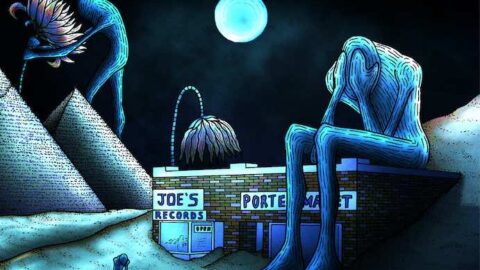The video trailer for Akropolis Reed Quintet’s new album Ghost Light (New Focus Recordings) holds a reverent visual space for this collection of pieces about death, life, and honoring the spirits that inhabit these realms. Filmed in a dark room, a lightbulb at its center shines softly onto the musicians encircling it. The camera’s focus shifts from one musician to the next as oboist Tim Gocklin, clarinetist Kari Landry, saxophonist Matt Landry, bassoonist Ryan Reynolds, and bass clarinetist Andrew Koeppe each emerge from the shadows for a brief moment before fading back into the dimness. UK-based artist Ashton Springer’s work graces the album cover, his eery, moonlit landscape and its many solitary characters depicted in vivid aquamarine.
The album begins with a work inspired by a culture for whom death was an obsession. Stacy Garrop’s Rites for the Afterlife draws on her love of the myth and lore of Ancient Egypt and takes the listener on a journey of the soul, with each of the four movements sonically describing trials of the afterlife. Warm timbral trills and expectant, uneasy dissonances depict a soul slipping from life, blanketed with blessings thanks to prayers written in stone upon their tomb. Low growls in the bass clarinet and frantic flurries in the saxophone add to a sense of spiritual unease (Garrop’s wish here is to put the audience in the seat of a funeral barque alongside the recently departed, drifting into the netherworld on a river infested with dangerous and horrifying creatures of the afterlife). Final salvation can be felt in the gorgeous harmonies that move slowly between instruments as this soul is accepted into paradise for the rest of time.

Michael Gilbertson’s Kinds of Light is a celebration of the wide palette of colors that can be achieved by Akropolis Reed Quintet’s instrumentation. Each movement combines the ensemble in a different way, balancing register or timbre, optimizing for a specific sonic hue as all instruments move from note to note together in rhythmic solidarity. The reed quintet becomes more than the sum of its parts and achieves potent hues such as the soft violet proffered in “Movement II. Violet”, and the vivid, bright greens in the vivacious “Movement III. Fluorescence.”
The large emotional weight of Niloufar Nourbakhsh’s work Firing Squad was born from a small seed: a line from Gabriel Garcia Marquez’s One Hundred Years of Solitude: “Many years later, as he faced the firing squad, Colonel Aureliano Buendia was to remember that distant afternoon his father took him to discover ice.” The resulting piece takes a final moment of human existence and augments it to a 7.5 minute stream-of-consciousness work with tableaus flashing by like a lifetime of potent memories. Nourbakhsh manipulated recordings of Akropolis to create moments where the ensemble is faced with a mirror version of itself; an artistic structure akin to a person suddenly coming face-to-face with their life in their final moments. The crux of this work is absolutely magical: bi-aural beats loudly shimmer in and out of focus, unisons aching as they graze against each other and disintegrate into jagged harmony. The work ends in a haunting tutti exhale…a literal last breath.

Theo Chandler’s Seed to Snag is a powerful and profound meditation on birth. In the first movement, “Sprout,” thin lines unfurl like vine tendrils, timid and tentative. Single melodic fragments gradually fork into two; crescendoing into a cornucopia of verdant melodic growth. This work is a musical onomatopoeia, its score depicting visually what the music is portraying aurally. The second movement is dark and sparkling, with a bassoon line so beautiful that your mental gaze remains fixed AND transfixed the whole way through. The third movement takes textures from the first and augments them; brilliant eruptions of florid color give long moments of ecstasy to the final minutes of this work.
In his four-movement work, Homage to Paradise Valley, Jeff Scott takes us through the history of a neighborhood in Detroit: its beginnings as a fertile plain called “Black Bottom” for its dark, rich soil; its heyday as a hub for musical creativity; and its eventual decimation as this predominantly Black neighborhood was razed to make way for new development. Poet Marsha Music’s voice gives Detroit an origin story shaped almost as an Epic Poem, and her words act as literary interludes before movements I, II, and IV, setting our minds alight with images and sensations that Scott’s music fully fleshes out.
Akropolis Reed Quintet has done a beautiful job with this album. Not only do they perform these works with faultless detail and refreshing artistry, but they’ve given a reverent temporal space for the stories these composers decided to tell. It’s a true joy to sit and listen to these colors and tales that softly haunt you after the last track stops.
I CARE IF YOU LISTEN is an editorially-independent program of the American Composers Forum, funded with generous donor and institutional support. Opinions expressed are solely those of the author and may not represent the views of ICIYL or ACF.
A gift to ACF helps support the work of ICIYL. For more on ACF, visit the “At ACF” section or composersforum.org.
























